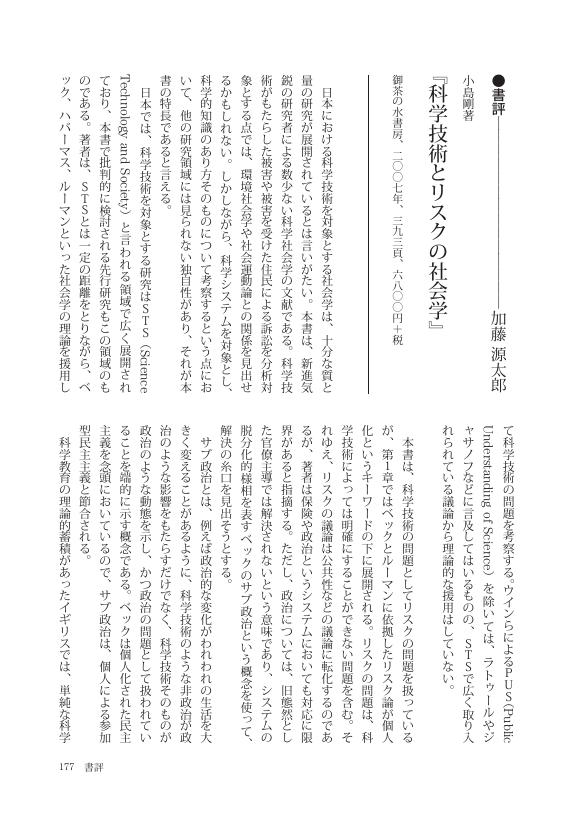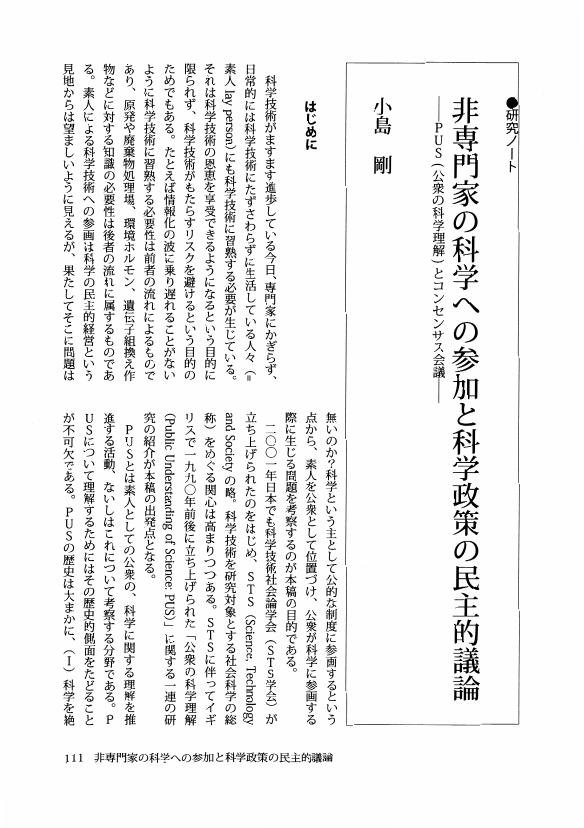14 0 0 0 OA 幹細胞の規制に関する国際動向の研究
- 著者
- 小島 剛
- 出版者
- 科学社会学会
- 雑誌
- 年報 科学・技術・社会 (ISSN:09199942)
- 巻号頁・発行日
- vol.19, pp.79-100, 2010-06-30 (Released:2022-09-10)
5 0 0 0 OA 小島剛著 『科学技術とリスクの社会学』
- 著者
- 加藤 源太郎 小島 剛
- 出版者
- 社会学研究会
- 雑誌
- ソシオロジ (ISSN:05841380)
- 巻号頁・発行日
- vol.53, no.2, pp.177-185, 2008-10-31 (Released:2015-06-06)
3 0 0 0 リスク社会論の検討 : 個人化とシステムの限界
- 著者
- 小島 剛
- 出版者
- 学術雑誌目次速報データベース由来
- 雑誌
- ソシオロジ (ISSN:05841380)
- 巻号頁・発行日
- vol.46, no.3, pp.19-35, 2001
3 0 0 0 IR <書評論文>ルーマン理論における近代像
- 著者
- 小島 剛
- 出版者
- 京都大学文学部社会学研究室
- 雑誌
- 京都社会学年報 : KJS = Kyoto journal of sociology
- 巻号頁・発行日
- vol.7, pp.251-258, 1999-12-25
3 0 0 0 OA <書評論文>ルーマン理論における近代像
- 著者
- 小島 剛
- 出版者
- 京都大学
- 雑誌
- 京都社会学年報 : KJS
- 巻号頁・発行日
- vol.7, pp.251-258, 1999-12-25
1 0 0 0 OA 非専門家の科学への参加と科学政策の民主的議論 PUS(公衆の科学理解)とコンセンサス会議
- 著者
- 小島 剛
- 出版者
- 社会学研究会
- 雑誌
- ソシオロジ (ISSN:05841380)
- 巻号頁・発行日
- vol.48, no.1, pp.111-127, 2003-05-31 (Released:2016-05-25)
- 著者
- 愛甲 和秀 木下 雅文 小島 剛 畑﨑 恵介
- 雑誌
- 研究報告システム・アーキテクチャ(ARC) (ISSN:21888574)
- 巻号頁・発行日
- vol.2015-ARC-215, no.5, pp.1-7, 2015-05-19
昨今,注目度が高まっている並列処理システム Spark の障害復旧処理モデルでは,データ量やタスク処理時間に連動してダウンタイムが長くなる,可用性劣化が問題となる場合がある.本研究では,Spark の可用性劣化の原因となるデータ復旧処理時間を短縮するため,Spark のメモリ上のデータ管理をインメモリ KVS で代替する方法を提案する.本方法は,データ書き込み時のノード間でのインメモリデータ複製処理と,障害時のノード内のインメモリ KVS のデータ配置情報と Spark のデータ配置情報の同期処理により,上記復旧処理時間を短縮する.その結果,従来法では障害復旧時間が数分かかる場合においても,提案技術を適用することによりダウンタイムを常に5秒以内に維持できるとの評価結果を得た.以上の結果から,提案方法が Spark のダウンタイムが増加する可用性問題の解決に有効であることが明らかになった.
1 0 0 0 OA 公衆の科学理解に関する一考察 : イギリスにおける医療・環境問題から
- 著者
- 小島 剛
- 出版者
- 京都大学
- 雑誌
- 京都社会学年報 : KJS
- 巻号頁・発行日
- vol.9, pp.149-164, 2001-12-25
The purpose of this paper is to consider how the public who are not engaged in special scientific work understand and interact with science. Recently we are surrounded by various risks caused by science, so the public needs to know and participate in increasing more scientific related affairs. To deal with this issue of "Public Understanding of Science", first, we sum up the scientific enlightenment action and policy during the twentieth century in the United Kingdom. We refer in particular to the Royal Society's report The Public Understanding of Science. In this report an evidence is found of aims to increase the publics understanding of science for national prosperity, and a "deficit model" is given which regard the public as scientifically vacant, ignorant people. On the contrary, there are studies that aim to make it clear that the public understanding of science has its own actuality and positive significance. We take Misunderstanding Science? as the representative study of this kind. Two examples in this book are introduced in this paper, one explains how the patients of Familial Hypercholesterolaemia get on with scientific and medical knowledge, and the other explains how sheep farmers around the Sellafield Nuclear Plant get on with the scientists sent from the United Kingdom. From these examples, we can find that there are rationalities in the lay public's scientific judgment. However, these examples are local and specific, so in order to make it clear that the lay public's scientific judgment has the great power to make scientific policies more democratic, we introduce global consumers' action against Royal Dutch Shell concerning the Brent Spar, an old oil rig that was dumped in the Atlantic ocean. This affair happened as global consumers ignored the authorized scientists' opinions, displaying the power of the public's own judgment. The main theme of this paper, that the public understanding of science has the critical power for scientific governance, is arranged in the last section.




